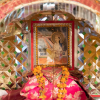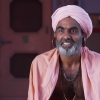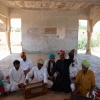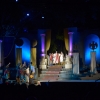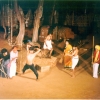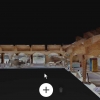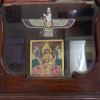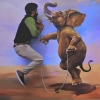Sahapedia: Cultural patrimony is a divisive issue, with some people suggesting an internationalist perspective, in which art is seen as belonging to humankind in general and that countries which have more developed modes of preservation, should therefore be given locational preference. Whereas others say any object removed from its context loses all meaning and becomes merely a commodity. What do you feel?
Harsha Vinay: A few months ago, en route to a friend’s wedding outside Bangalore, I had stopped to refuel the car when I suddenly noticed a crowd of standing figures: a bizarre variety of statues placed beside the road and under a flyover. Many were ‘waving statues’, some of these gold-painted, others were just standing in stoic positions, arms akimbo. Among the few I could easily recognise were Krishna, Nehru, Vivekananda, a Rani Laxmibai lookalike, and more. While I stared in awe, I noticed, in one corner two well-carved, unpainted, stone sculptures, idols of Shiva and Parvati, most likely of an ancient make. When I enquired with the man at the petrol pump how these idols got here, he shrugged and said, 'Most likely leftovers from the temple that was demolished to build this flyover.'
Yes, cultural patrimony is a divisive issue, but no, objects removed from their context do not become mere commodities, because they already exist in a decontextualized space. ‘Context’ in today’s world needs to be understood as a fluid term that must remain adaptable in order to accommodate an evolving cultural landscape.
In the case of the Sripuranthan Nataraja, or other national treasures that ‘leave’ the country, a peek into India’s preservation and restoration policies will reveal the State-designed ‘contexts’ within which many such sculptures reside today. India’s artistic, architectural and cultural heritage of both the tangible and intangible kind, is taking a beating thanks to outdated colonial laws such as the Ancient Monuments Preservation Act, 1904, or the Ancient Monuments and Archaeological Sites and Remains Act, 1958, which do not take into account cultural or religious exchanges in the past, changing socio-economic patterns, urban development, or migration in the present. A consequence of such narrow, rigid laws that enforce land acquisition, is the transformation of ‘ancient’ monument spaces into ‘theme parks’, with sprawling lawns, gardens, deer parks, souvenir stalls and fun fairs!
It comes as no surprise then that sculptures like the one in question, and others that exist is numerous religious or ancient ‘protected’ sites across India are ‘stolen’ and allowed to disperse into the international arena. Alternatively, the comparatively more recent and internationally accepted Nara Document on Authenticity, formed in Japan during the World Heritage Convention in 1993, frames a more flexible and inclusive attitude to authenticity. It states that monuments should not be restored only with the aim of maintaining their authenticity or originality; they should be inclusive of communities and culture.
S: The case of the Sripuranthan Nataraja, reveals the complexity of viewership—the idol once restored to the temple will be viewed by devotees, whereas in Canberra it would have been viewed by museum visitors. What according to you is the difference and is there a way in which both ‘ways of seeing’ can be brought together?
H.V.: Sure, there is a difference, and there have been attempts to brings the two ‘ways of seeing’ together. During the mounting of ‘The Body in Indian Art and Thought’ exhibition (which I was a part of), at Palais des Beaux-Arts, Brussels, in October 2013, the exhibition design in some of the galleries created the ‘experience’ of a sacred space, through its narrative. The gallery titled ‘Astrology’, for example, had numerous sculptures laid out in niches with the intention of recreating a sense of a temple complex structure. In her article ‘Our Gods, Their Museums’, Tapati Guha-Thakurta has elaborated on two different approaches made by the Smithsonian and Sackler Gallery at bringing these two ‘ways of seeing’ together, through the ‘re-constitution of the living spaces of devotion’.
In conversation with a senior artist and art educationist from Bangalore, I learnt that, in the early 1980s, when the National Gallery of Modern Art, New Delhi hosted group exhibitions of post-Independence Indian artists, many visitors, especially the groups that arrived in tourist buses on journeys of devotional places, would seek darshan at many of the sculptures and paintings. He said, 'It didn’t matter to them if these paintings were abstract or realistic, when they would see a Hanuman, or Saraswati, or a Rishi, they would bow down, offer their prayers and seek darshan.'
This then means that a platform where both forms of viewership can co-exist is as much a matter of perspective or a mindset as it is a physical space. To me, protected monuments such as Humayun’s Tomb, or the Qutub complex in New Delhi that have been painstakingly restored and are carefully protected, are no different from modern-day mainstream museum spaces. Today, Western art museums too function as a complex site for the production of new orders of ‘religious’ value around Indian sculpted objects. So, many forms of ‘co-existable’ spaces are being attempted now.
S: As a curator, what do you feel is the impact of the ‘market’ on the way culture is being collected and curated, at private, public, national or international levels?
H.V.: The ‘Orient’, in the Edward Said sense of the word, never ceases to interest the West, and thus museums internationally continue to collect and exoticise what is now the ‘in’ thing: ‘Asian’ art. The market surely influences and continues to influence the curation of culture. If we take modern art for example, its collection and curation is becoming increasingly challenging due to the sheer scale of art works being created. Art left the home a long time ago; it left the gallery to move into art collection spaces and museums about five years ago, and is now in the process of moving out of these enclosed spaces and into the street. The state is struggling to balance its own need to control, collect and curate modern art vis-a-vis modern art’s need to break away from all limitations and remain ‘boundary-less’. The hope is that an entire street or even a township can be preserved through the existence of modern art. For example, if M.F. Hussain was to paint all the walls of a street, how would one collect the art without making it inclusive of the community?



